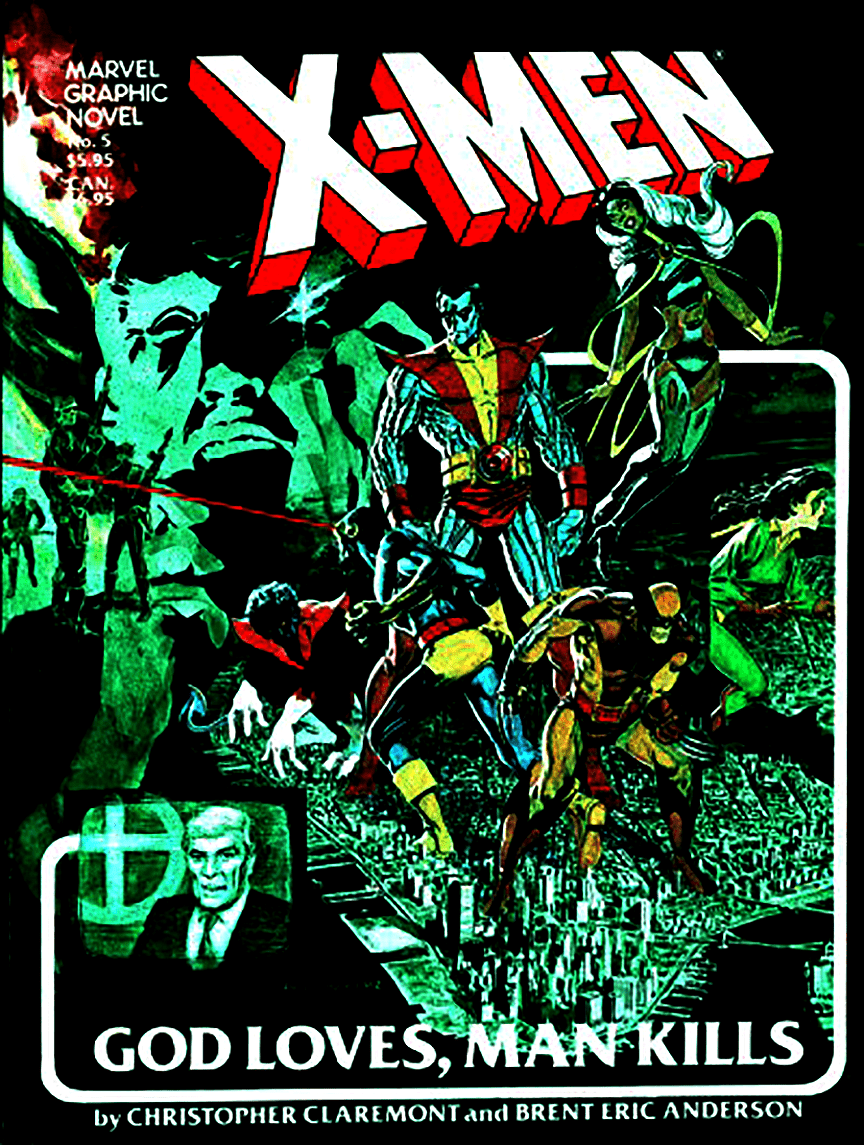
By the end of the Brood Saga, the X-Men had taken its first step into becoming a franchise title for Marvel. While Chris Claremont had told years of stories with the X-Men by this time, some referenced or featured in other titles, the main adventures were told completely in one series, Uncanny X-Men. By this time, there was a second title, The New Mutants, focusing on the junior team of mutant heroes under the tutelage of Charles Xavier. For more depth on that book, I’ll simply refer you to “A Brief History of the New Mutants”, which covers Claremont’s overall direction for those characters.
However, this also presented new territory for Uncanny X-Men, which had to account for the presence of a second team living at the X-Mansion. In fact, this may be the first time that two super-teams were living under the same roof, sharing the same writer and the same continuity. Claremont had initially accepted New Mutants reluctantly, but he had done so because he wanted to maintain control over the direction of the X-Men and their related projects. Eventually, there was a clear direction for each book; Uncanny X-Men was the soap opera adventure title, while New Mutants was the experimental book that explored Claremont’s more bizarre concepts. It was a good division of labor that allowed the X-Men to remain what they always had been, while New Mutants allowed Claremont to stretch his creative wings with new characters and more unconventional ideas. This also raised the question of what would be done with Kitty Pryde, the teenaged evergirl heroine of the X-Men, but that would be answered in the pages of Uncanny X-Men.
Before we can address that, we must turn our attention to some of Claremont’s side projects that he produced during this period. Two of them are regarded today as classics, and this is easily Claremont’s most successful period since John Byrne left the title. Because Claremont had been far ahead on scripts on Uncanny X-Men around this time, he was able to focus his efforts on other projects. This famously included the first arc on New Mutants, which became a Marvel Graphic Novel. However, this period also included another Marvel Graphic Novel called “God Loves, Man Kills”, as well as the classic Wolverine limited series. These stories are very often included on lists of Claremont’s all-time greatest X-Men stories and are generally considered to have stood the test of time.
The weakest of these, unfortunately, was Uncanny X-Men Annual #6, “Blood Feud”, the sequel to Claremont’s classic Dracula story. On paper, this story should have been more successful, especially since Bill Sienkewicz had returned to draw the annual. In complete fairness, Sienkewicz completely delivers on a visual level, and his art is easily the best part of the issue. He still masters the Gothic approach of the vampire story, and Dracula is still an imposing and majestic figure as drawn by Sienkewicz. He likewise draws an excellent Storm and Rachel van Helsing, and these two characters embody the best attributes of Claremont women; they look as powerful as they are beautiful, and clearly Sienkewicz took pleasure in drawing these characters.
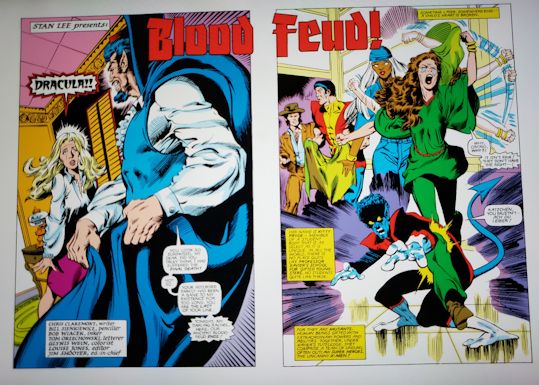
The writing doesn’t serve them quite as well as the art, unfortunately. Some of it may be that Claremont no longer had the Stoker formula to draw on; the strength of the original Dracula story came from the thematic adherence to Stoker’s novel. With the pressure to make the second as good as the first, it’s possible that Claremont decided to stray from what worked before. Perhaps there were crossover and marketing considerations involved as the X-Men became popular, and the direct tie-ins with the Tomb of Dracula characters ended up limiting this story. It may even be that Claremont wanted to do something big and shocking with this annual, to set this story apart from more forgettable previous annual stories he’d done. The result, however, is a story that is memorable only for the death of Rachel van Helsing, the main heroine of Tomb of Dracula, after she serves as an unwilling antagonist.
Rachel van Helsing, as one might imagine, is the descendant of Dr. Abraham van Helsing, vampire hunter and nemesis of Dracula in Stoker’s original novel. She is an original Marvel character and featured in Tomb of Dracula, where she was involved in many memorable stories in that title. She was also the love interest of Frank Drake, the mortal descendant of Dracula and a key character for most of Tomb of Dracula. Claremont wisely brushes most of that history aside, referring only to a recent breakup between Rachel and Drake. Thinking Dracula to be destroyed, Rachel accepts a teaching position at Bard College (a real institution where Claremont himself had studied). Her life abruptly ends when Rachel is ambushed by Dracula, who turns her into a vampire and places her under his mind control.
The scene shifts to the X-Mansion, where Kitty is throwing a large tantrum over her parents’ divorce. Claremont rarely features Kitty’s parents, though he would sometimes show her receiving letters from them at school. He’s much less concerned about her parents as characters and more interested in how their relationship affects Kitty. In this case, the news of their divorce shatters Kitty’s innocent worldview, and she lashes out with anger. She’s in no fit state to hear reason from anyone, including her fellow X-Men, as she rages against her parents. This unwittingly opens the door for Kitty to be possessed by a mysterious being with an agenda against Dracula.
Some time later, Dracula uses his link with Storm established in the previous story to summon her to his side. This is significant because he does so in violation to his word as a nobleman, a breach of trust and honor. Even though Dracula is a villain and a monster, he holds on to vestiges of his previous life, including his pride and honor as a Transylvanian prince. Dracula breaks his word, but he does so out of desperation, fearing that the mystical Montesi Formula would be used to destroy him. He summons Storm against her will to perform a task for him—steal the mystical book that contains the formula. She finally agrees to do this task willingly, but only if no one will be harmed and the X-Men are not involved. Dracula charitably agrees to these conditions, seeing it preferable than compelling Ororo to do it. As we find out later, Rachel’s will struggles against Dracula’s mind control, and Dracula may have decided not to fight two strong-willed women at the same time out of personal convenience.
This begins a game of manipulation between Dracula and his mysterious rival, who is eventually revealed to be Lilith. Though there are several characters at Marvel that have called themselves Lilith, the Lilith in this story is the daughter of Dracula. This Lilith is another character created by Marv Wolfman as part of the Marvel Dracula mythos, although Steve Gerber was also closely associated with her. Like Dracula, she is a vampire, but she is mystically bound to be her father’s eternal nemesis. She is a bit different in nature, however, as she possesses women who hate their fathers and wish them dead. For a brief moment, Kitty’s hatred of her parents opened the door for Lilith to take over her body. Lilith remains the eternal nemesis of her father, but by the nature of the magic that binds her, she cannot directly kill her father. She must, therefore, use others towards that purpose, seeing the Montesi Formula as a means to that end.
Ultimately the plan fails due to the intervention of Nightcrawler, who recognized the evil of the mystical Darkhold tome. His reasons for this are good ones; Kurt fears that Kitty will lose her soul if she casts the Montesi Formula. As someone who was raised by and among sorceresses, Kurt may have acted with some wisdom here, though in this case it unravels Lilith’s plan. “Kitty” finally reveals herself as Lilith, who remains unable to destroy Dracula herself as part of the spell that binds her. The X-Men take that task upon themselves, and they eventually succeed in destroying Dracula and freeing Storm and Rachel. Kurt plunges a spear through the vampire’s heart, and Wolverine beheads what remains of his body. Dracula would return to torment the X-Men again, but not until long after Claremont had finished his first run on the book.
The best and most memorable scene of this issue takes place in the epilogue. By this time, Rachel van Helsing has become fully a vampire, unable to return to who and what she was. She has become truly the monster she swore to destroy, and she no longer wishes to live as one of the undead. Storm initially considers killing Rachel herself, and she is certainly capable of driving the stake through her heart.
However, Wolverine stays Ororo’s hand, and he offers to take Rachel’s life instead. As Logan succinctly puts it, “killin’s my profession”. Logan doesn’t do this out of hatred, but out of compassion and the drive to protect Ororo from the consequences of the act. He sees killing Rachel as a mercy killing, and he takes the responsibility on himself so that Ororo doesn’t have to deal with the guilt or the consequences. Rachel’s death is a sad, poignant moment, but she dies with dignity, as herself. There have been far worse deaths in comics, and this is a rare death that has generally stood the test of time.
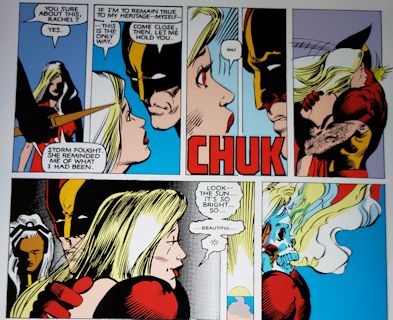
Despite how good her death scene is, I can’t help but think that Rachel’s character is wasted in this story. It may be that Marvel had always planned on killing off most of the Tomb of Dracula characters around this time, and that Rachel would have died somehow. At the same time, she might have contributed far more had she lived, especially during the Midnight Sons era in the 90’s or later, when Blade became a household name with the Wesley Snipes films. She also doesn’t die while doing something of great value to the story, either this one or to the larger Dracula narrative. While Claremont handles her death perhaps as well as he could in this story, and her final scene is excellent, she could have been so much more than this.
That in many ways is the true tragedy of this X-Men annual: the unrealized potential. This issue should have been great, at least in theory. Claremont and Sienkewicz are undoubtedly an excellent creative team, and Dracula is a great villain. Rachel van Helsing is a great character who could have brought much to this story, as is Lilith. In the end, the story doesn’t have the impact it should have, and the Lilith reveal would have been obvious to anyone familiar with Marvel horror titles. The art is excellent and the final scene with Rachel is beautiful and touching, but everything leading up to it falls relatively flat.
From here, we’ll turn our attention to God Loves, Man Kills, considered by many to be the greatest X-Men story in the post-Byrne era. This one is personally one of my favorite X-Men stories, over even the likes of Days of Future Past. What makes this story great lies in its simplicity. God Loves, Man Kills was intended by Chris Claremont and Louise Simonson to be a simple, done-in-one story that encapsulated what the X-Men were about in a complete package. It was the X-Men’s mission statement in a single story, not necessarily connected to main X-Men continuity, but still felt like it was part of the larger narrative. GLMK very much succeeds in that respect, so much so that it eventually became the inspiration for the second X-Men movie.
Part of the reason for this is that GLMK taps into the core themes of the X-Men. This is a darker story, one that is a commentary on racial hatred and bigotry. However, it was also inspired by the televangelism of the mid-1980’s, which at that time was flourishing. As someone who was there at the time, Claremont’s fears about religious zealotry and corruption within these groups were not without foundation. For instance, years after this story was published, Jim Bakker publicly fell from grace after his personal and financial scandals came to light. It is certainly possible that Bakker was one of the influences for Reverend William Stryker, the villain of this story. More than that, Claremont was concerned by how faith could be weaponized, how it could be manipulated as a force for racism and hatred. Claremont would eventually say in later years that he regretted that the world even today had not fully learned the lessons of God Loves, Man Kills. While it’s not the intent of this retrospective to delve too deeply into the political themes or implications, they form the foundation of Claremont’s thesis with GLMK and should be considered as he intended it.
Beyond that, God Loves, Man Kills is a study of faith and how each of the X-Men consider their relationships with the divine. We’ve seen Claremont explore faith in various ways in previous X-Men stories, such as the Brood Saga or the first Dracula story. Here, Claremont dives into the power of faith, not simply as a destructive force, but also how it can be used as a force for good. It should be noted that Claremont never outright rejects faith, though characters like Wolverine certainly do. Nightcrawler is a practicing Catholic and Kitty’s Judaism is an important part of her character. Where Reverend Stryker represents the corruption of faith towards racism and hatred, Kurt and Kitty represent faith as a positive force, to inspire hope and bring people together in love and friendship. Though Stryker and his Purifiers are truly evil villains, Claremont never treats faith or religion as negative intrinsically. GLMK is a study in how faith is applied, and how it could be used for good or for ill.
There have long been questions about the canonicity of God Loves, Man Kills. For a long time, this story was not officially regarded as canon by Marvel, as it was intended to be a standalone story that was disconnected from it. That changed under Editor-In-Chief Joe Quesada much later. In the early 2000’s, when Claremont was writing X-Treme X-Men and the second X-Men film was released, Marvel reversed that decision. Since then, God Loves, Man Kills has remained a solid part of X-Men canon. Reverend Stryker has even returned as a recurring villain over the years in various X-Men titles.
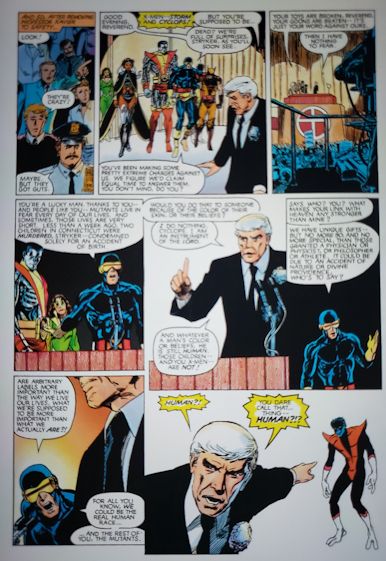
Still, it is not clear where exactly the story fits, as it was never specified. Most likely this story would have taken place just after the Brood Saga, though it’s a tricky fit. The mansion is intact, Illyana is a teenager who hadn’t yet revealed her true nature as a sorceress, and none of the other New Mutants are mentioned in any way. Magneto hasn’t fully reformed by this time, though he’s an ally of the team against Stryker. Xavier is also still in the wheelchair by this time, and no mention is made of that situation. However, the most likely interpretation is that this took place just after Xavier’s mind was transferred into the clone, and his inability to walk is the result of his psychosomatic symptoms. To the best of my knowledge, the answer has never been concretely laid down, so you’re welcome to apply your own headcanon to the chronology.
The story begins with the cold-blooded execution of two black mutant children in a playground a night, a murder committed by Stryker’s Purifiers. The identity of the children is important because it hits directly to Claremont’s themes, the idea that religion becomes a force to “other” people into something inhuman. The dehumanizing of individuals makes violence against them more acceptable, and indeed, the Purifiers show no remorse whatsoever about this horrific act of violence. Although the surface-level narrative is that the Purifiers murder the children because they are mutants, Claremont uses the subtle detail to show the real racism that he uses the story to condemn.
It is interesting, then, that Magneto Is the character that arrives to openly condemn the murders. This is the first time we’ve seen Magneto since Uncanny X-Men #150, where he retreated out of remorse for having nearly killed Kitty in a fit of rage. There is a certain hypocrisy on Magneto’s part in all this—he had no problem with violently attacking the original X-Men when they were teenagers, in addition to nearly killing Kitty. However, to Magneto, it matters that the dead were mutant children, and thus he sees kinship with them, mourns the loss of these lives that have been brutally destroyed in the name of Stryker’s religion. In their name, Magneto vows to hunt down the Purifiers and impose his own brand of mutant justice on them.
Kitty takes center stage in the following scene, where she erupts into a fist fight with another student at Stevie Hunter’s dance school. Kitty has always had one major character flaw—she has a wicked temper, which at times has gotten the better of her. Kitty is especially sensitive when it comes to her sense of right and wrong, and bigotry is one of her most explosive emotional triggers. Stevie breaks up the fight and we learn what caused it—Kitty’s classmate had repeated Stryker’s anti-mutant rhetoric, causing Kitty to throw the first punch. Kitty’s hot temper gets the worst of her here, as she loses the fight after a distraction, and then she unloads her anger on Stevie when she tries to defuse the situation. Kitty makes her point about how hurtful words are, using an offensive racial slur to drive the point home to Stevie. While one might argue that the slur was unnecessary and hurtful, it causes Stevie to rethink her own position, and raises questions for the reader to consider.
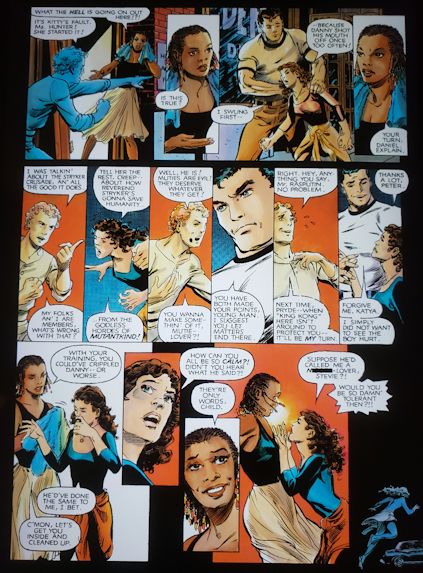
Prior to a practice session in the Danger Room, the X-Men watch an episode of ABC’s Nightline, where Xavier and Stryker debate their respective visions of mutantkind. Xavier advocates for mutant/human tolerance, while Stryker preaches his anti-mutant rhetoric. However, because Stryker is far more charismatic than Xavier and skilled at using the media, he manages to win the televised debate. Still, there is more going on beneath the surface; a simple exchange between Scott and Stryker’s associate Anne leads to a tracker being planted on the X-Men.
Anne is a noteworthy character because she changes over the course of the story. Outwardly, Anne is a young woman who works for Stryker. Secretly, however, she is the leader of the Purifier strike team, and she proves to be a capable field leader. She was the leader of the Purifier execution squad that murdered the children at the beginning. After the debate, she leads the squad that tracks down the X-Men’s car, then kidnaps Xavier, Cyclops and Storm. Anne mostly seems to be a cool, professional holy warrior, and she’s skilled enough to stage a car accident, leaving the X-Men to believe their leaders are dead. She ends up being a solid soldier villain for the Stryker Crusade, and she gets the best of most of the X-Men during this story.
The next day, Kitty is venting her frustrations with Illyana out on the school grounds. The conversation then turns to Kitty’s relationship with Peter until Kitty discovers a motion sensor out amidst some of the vegetation. Kitty and Illyana decide to hide and ambush whoever planted it, while the other X-Men investigate the faked car crash and what happened to Xavier, Scott, and Ororo. Both teams run afoul of Purifiers, as Anne kidnaps Illyana, Kitty is hit with nerve gas, and the other Purifier team faces the X-Men in a suit of high-powered armor. Fortunately, the X-Men are saved with the arrival of Magneto, who defeats the armored Purifiers and agrees to an alliance with the X-Men.
The following scene deals with Magneto and the X-Men as they attempt to extract information out of the surviving Purifiers taken as prisoners. This scene takes a somewhat darker turn, as the heroes must decide how to get the information without using excessive force. Normally, Logan would be the one to scare the Purifiers into submission, but he fails even with his scariest efforts. In the end, it’s Magneto who manages to frighten them enough into revealing who they are and who they work for—the Stryker Crusade. However, Magneto is no stranger to torturing his enemies, and even though the end is a good one, the X-Men have doubts about their methods. Claremont uses Kurt to speak to those ethical concerns, as a voice of honest faith. The story provides no comfortable answers, and leaves the question unaddressed, allowing the reader to consider those points.
What follows is a drug-induced dream from Xavier’s perspective, as Stryker’s people attempt to control Xavier’s mind. Inside, we see a mixture of religious imagery with the X-Men cast as demons while Xavier is crucified, with Bible quotes used to elaborate on the scene. Xavier is represented as a martyr for the mutant cause, preyed on by his own children as he suffers. A demonic Cyclops taunts Xavier with his own subconscious guilt: “We lived and fought for you, Xavier—and you gave us nothing but death and dishonor! The debt’s long overdue!” It’s clear from this that Charles Xavier on some level knows how much his own crusade has cost, both in his soul and in terms of casualties. Stryker attempts to break Xavier by tormenting him with his own guilt, using the pain Xavier has caused his students as a weapon to undermine his will.
In the end, Xavier is perhaps not so different from Stryker beyond their goals and methods. Both men believe in their visions with a faith that arguably reaches the fanatical. They also both derive their faith as a way of assuaging their own guilt issues. Stryker has his own sins to bear, but Xavier no less so with his mistreatment of Gabrielle Haller and his creation of the X-Men. On a deep level, Xavier believes he has failed his children, and though it’s not openly stated, this guilt and sense of failure likely stems from the deaths of John Proudstar and Jean Grey. He has turned his students into crusading soldiers for his cause, asked them to suffer tremendously, and Xavier feels an unexpressed regret for it. In the end, Stryker’s drugs and machines break Xavier’s will enough to make him a mental slave to Revered Stryker.
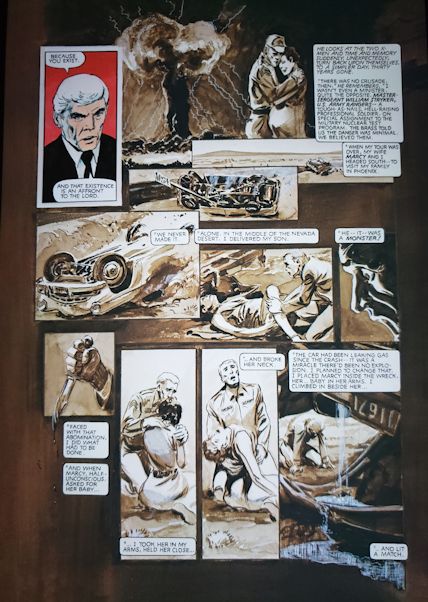
After a brief exchange with Scott and Ororo, Stryker reveals his origin and his reasons for wanting to exterminate mutantkind. In his youth, Stryker had been a sergeant in the US Army Rangers, assigned to a military nuclear test program. The military falsely assured him that this had no ill effects on Stryker and his pregnant wife Marcy. This turned out to be untrue, and it’s implied that they were affected by radiation exposure. On a drive in the Nevada desert, the Strykers suffered a horrific car accident while Marcy was in labor with their child. The baby was born a mutant, with visibly inhuman features. Regarding his mutant child as a monster, Stryker murdered the child and then broke his wife’s neck. Unable to cope with what he’d done, Stryker turned to drinking and fighting as an escape until he was dishonorably discharged from the Army. Later, he discovered the existence of mutants, realized his son was one, and then blamed mutantkind as the work of the Devil.
Here Claremont exposes his true point, the danger of utilizing faith to rationalize racism and bigotry. Although William Stryker is an evil man, one that disguises sin in the robe of godliness, his true sin is willful blindness to the truth of his own actions. Stryker killed his own family out of fear and bigotry, and ever since, he has been searching for a way to avoid personal responsibility for his own behavior. When drink and bloodlust failed him, Stryker turned to faith as an opiate, desperate to blame anyone but himself for what he did. And because nothing can ever be Stryker’s fault, all of mutantkind must be blamed so that Stryker never suffers from his own guilt. In the end, Stryker is not a villainous caricature, but the kind of evil that could exist, one that is born of moral blindness… and that may be the greatest sin of all. Stryker willingly lives a lie so that he can live at peace with himself while an entire group of innocent people suffers. His faith, his entire crusade, is not about God at all, but about protecting the ego of a broken man who lies to himself upon a mountain of corpses.
In the meantime, Kitty turns up alive, having protected herself partially from the nerve gas by phasing at the right moment. However, the Purifiers have Kitty on the run, chasing her through the streets of New York City. After a harrowing escape, Kitty reaches a train, but the Purifiers eventually catch up to her. Magneto and the X-Men quickly arrive to rescue Kitty, and in time, manage to rescue all of the remaining X-Men except for Charles. By this time, Xavier has been successfully brainwashed as a weapon of the Stryker Crusade. Stryker intends to use Xavier’s telepathic powers to kill anyone with mutant abilities. He plans to test this at a televised sermon that Stryker plans to give at Madison Square Garden, with a large audience in attendance. This sets up one of the strongest, most dramatic finales ever seen in an X-Men story.
Magneto crashes the sermon as Stryker begins, and a brainwashed Xavier launches a powerful psychic attack against his old friend. In the meantime, the X-Men try to reach the sermon to free Xavier. Along the way, we see how truly terrible Stryker has become. Anne realizes that she’s vulnerable to Xavier’s anti-mutant psychic wave… and therefore a mutant. When Anne begs Stryker for mercy, he rejects her and pushes her off the podium to her death. As Stryker says, “I am set upon a righteous course, Anne. Nothing—and no one—will deter me from it! A true daughter of Heaven would have accepted her fate.” This passage is chilling and shows the true depth of Stryker’s depravity. By this time, Stryker is so lost in denial, so unwilling to accept responsibility for his acts of murder, that he chooses to sacrifice even his most loyal associate rather than face the truth. His casual dispatching of Anne on live television demonstrates that William Stryker would do virtually anything to convince himself that he’s a righteous man of God rather than the murderer he truly is.
By now, however, it has become clear to the world around him what Stryker really is, but it’s left to the X-Men to make the moral case against Stryker’s crusade. Cyclops argues that it’s possible that mutants might be the true human race, and this idea only makes Stryker even more unhinged. He responds with one of the most classic panels in X-Men history with the following retort, pointing at Nightcrawler: “Human? You dare call that thing—human?!?” This is one of the most open and most disturbing displays of racism we’ve seen in X-Men up to this point. By this point, Stryker is truly exposed as the real monster, openly dehumanizing a good man—Kurt Wagner—while acting more and more irrational the more he’s confronted with the truth.
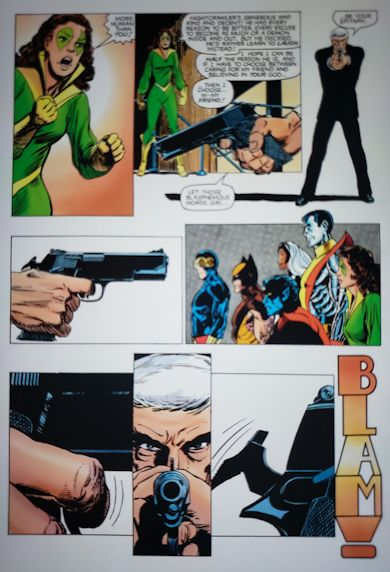
In the end, Kitty gets the last word in the argument, giving an impassioned defense of her friend Kurt and the ultimate condemnation of Stryker. “More human than you!” she exclaims, hitting the core of who Nightcrawler is as a character. Though Kurt looks like a demon, the point of his character is that he is not one, that he has a good and loving soul underneath his demonic appearance. Stryker proves to be the reverse of Kurt, a monster who pretends to be a man of God. To Kitty and to Claremont, humanity is represented by Nightcrawler’s virtues of honest faith, love, and compassion, virtues that Stryker long ago abandoned. Kitty concludes by saying: “I hope I can be half the person [Kurt] is. And if I have to choose between caring for my friend and believing in your God, then I choose… m-my friend!” It Is important that Kitty give this speech, not just as the everygirl of the team, not only as a believer in Judaism, but as a young woman who overcame her own fears to accept Kurt as a friend. Kitty manages to overcome her own fears and judgmental beliefs and change, while Stryker only retreats further into his own murderous denial.
With Stryker unable to win the argument, he tries one last ditch attempt to win. He attempts to shoot Kitty, who stands her ground against Stryker along with the X-Men. A shot goes off, but it isn’t Stryker who pulls the trigger. Stryker falls to a policeman’s bullet. It isn’t any of the heroes who finally stops Stryker, but a normal human who was convinced by the power of the X-Men’s ideas. He didn’t see a mutant or a monster, but a girl who was threatened by William Stryker. Although Kitty is in no real danger—she can phase through bullets—this moment is powerful because we see the X-Men’s message have a real, tangible impact on ordinary people. With that, Xavier is freed from the mind control, the X-Men leave in peace, and they all return to the X-Mansion along with Magneto.
In the final scene, Magneto encourages Xavier to join him, and for a brief moment, Xavier appears close to accepting his offer. It’s possible that Xavier is still in an unstable place emotionally, and that he’s still haunted by the specter of his own guilt and past sins. What Stryker showed Xavier is still a part of who he is. However, Scott defeats Stryker for the last time by arguing against Magneto, persuading Xavier that his dream is worth fighting for. He also makes a powerful argument against Magneto’s methods as well: “the means are as important as the end—we have to do this right or not at all. Anything less negates every belief we’ve ever had, every sacrifice we’ve ever made.” Xavier refuses Magneto’s offer, and Magneto departs. Their relationship is somewhat changed—by this time, Magneto still hasn’t accepted Xavier’s way, though he finally accepts the X-Men as friends.
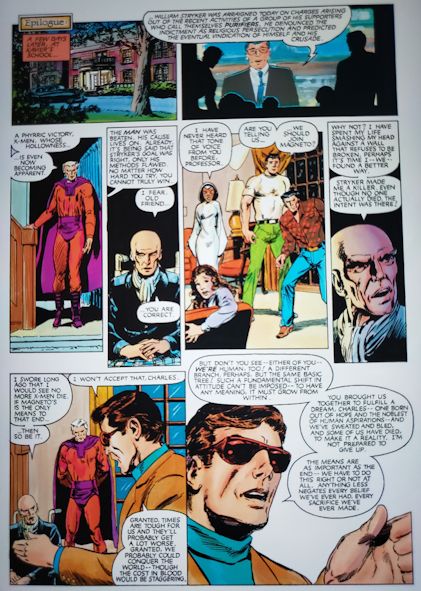
God Loves, Man Kills earns its place as one of the seminal and most memorable X-Men stories of all time. It is a morally and emotionally complex story, with an interesting and fully realized antagonist who embodies everything the team opposes. It remains a statement about faith, but also how faith can be corrupted and twisted against its proper virtues. It also remains a cautionary tale about belief and how it can be used to justify anything, no matter how terrible. Stryker is an outstanding villain, and the story is extremely well told. Brent Anderson’s visual storytelling is also outstanding, hitting just the right visual tones, and giving the story real emotional weight. His depiction of the Kitty/Stryker scene especially looks tense and powerful as drawn by Anderson. It is quite honestly a masterpiece of the X-Men canon.
In 2020, Marvel released an Extended Cut of God Loves, Man Kills. If you’re a fan of this story, it merits some interest, although I question whether it makes creative sense to publish this. The Extended Cut offers little more than a framing device set much later, not long after the X-Men: Black: Magneto issue from 2019, also written by Claremont. The framing device centers on a girl named Kate (no relation to Kitty), who Magneto befriended in the 2019 Magneto issue. Kate is the daughter of the owners of the Gold Star Café in a Texas town. In the Extended Cut, Claremont follows the Kate character as she meets Kitty, who tells the younger Kate the story of Stryker. Kitty leaves after telling her story, realizing that she’s being pursued by an anti-mutant federal operative named Warden. Warden threatens Kate, who is saved by her father, and Warden pursues Kitty elsewhere. The Extended Cut ends as Kitty looks at the situation from afar, finally reflecting on the past and what she’s learned from it.
The Extended Cut may be of interest if you’re a fan of Claremont, and I won’t discourage you from reading it if you’re interested in it. I feel Claremont contributed to this with good intentions—I can’t fault him for wanting to say more about his creations and about a story that means a great deal to him. Nor are the new pages badly written or drawn, and Brent Anderson returns for these new pages as well. However, in practice, it defeats the purpose of the original graphic novel. The Extended Cut unintentionally undermines the purpose of the original story, which is to tell a self-contained story that anyone can read and get the full picture of the X-Men. The Extended Cut adds in a bookend framing sequence that refers back to a story that likely only hardcore Claremont fans have read. That hurts its purpose as an accessible entry point to the series. It also doesn’t establish anything new or groundbreaking, or introduce any new points or ideas that build on his original thesis.
Moreover, Claremont and Anderson’s styles have both visibly changed in the last thirty years, enough that they aren’t recognizable as the writer and artist they once were. That isn’t a detriment or a strike against them, but time leaves a noticeable mark that impacts the work. The new pages are noticeably different from the original pages, to the point where it doesn’t feel like part of the same work. Finally, the collected version of the Extended Cut censors some of the language, possibly with Claremont’s involvement but certainly at the behest of Marvel editorial. While the Extended Cut does have some value, I would most recommend the original version, as it’s the truest to Claremont and Simonson’s original vision of GLMK and is the most impactful of the two. In either case, God Loves, Man Kills is a classic that any X-Men fan should read, and it may be the most accessible X-Men story ever published.
Finally, we’ll conclude this installment with my singular favorite Wolverine story of all time. By this time, Logan had already become an incredibly popular character, and Marvel wanted to see if he was able to fly as a solo character. Claremont had a story idea that he’d wanted to explore, but he was seeking out an artist who could bring that story to life. That artist presented himself in the legendary Frank Miller, who had already distinguished himself with his character-defining run on Daredevil. He and Claremont had worked together before briefly on Marvel Team-Up #100 (which introduced Karma), but this was the story that Claremont and Miller would be the best known for as a team.
The way that Claremont tells the story, he brought up the idea to Miller while they were driving to that year’s San Diego Comic Con together. As it was a long drive, Claremont and Miller were discussing story ideas on the trip to pass the time, and Claremont suggested the idea of Wolverine. Miller was initially reluctant to draw this series, since he was disinterested in drawing the adventures of a psychotic killer. (An odd objection in hindsight, considering that Miller later created Marv in Sin City.) Claremont was sympathetic to that objection, and instead proposed a different idea for the character. In Claremont’s eyes, Logan was a fallen samurai, a man striving towards the samurai ideal but held back by his animal nature. Miller was far more open to this idea, as it appealed to his own interests, particularly the influence of Eastern culture on Western comics. Miller was influenced by manga series such as Lone Wolf and Cub (Miller even drew covers for Western collections of that series), and his own stories often involved ninja (including Daredevil and even later work such as Sin City). Miller proved to be the perfect artistic choice for Wolverine, and the visual storytelling on that book is second to none as a result.
This was also a case of perfect creative timing, as Japanese culture was gradually spreading into the West. Anime and manga were beginning to make inroads during the early 80’s, and there was a growing interest in samurai and ninja in popular culture. It’s also quite possible that Claremont was influenced by works such as James Clavell’s Shogun, which had been a popular novel that was adapted into a television miniseries only two years before. Shogun dealt with the culture clash of a Western man into Japanese society, which the Wolverine miniseries also heavily focused on. Logan was also a good character to use for such a story, given his cowboy persona, his past involvement in Japan (hinted at in various X-Men stories), and his romance with Mariko Yashida, introduced during the Claremont/Byrne era. This was the right story at the right time, and that likely contributed to the book’s huge success.
Mariko Yashida is not a character that I’ve addressed often during this Retrospective, and it’s mainly because she had been at best a background character up to this point. She was the cousin of Sunfire (Shiro Yoshida), and a daughter of a powerful and respected family in Japan, but we knew little else of her. She was soft-spoken, genteel, and refined, but she was drawn to Logan, who was none of these things. Her romance with Logan was a union of opposites, but there was a real foundation there. Mariko was drawn to Logan’s personal strength and honest nature, while Logan saw in her the samurai that he hoped to become. This miniseries casts Mariko in a much different light, and after this, she becomes a much deeper and more involved character. In all honesty, Mariko is perhaps my favorite of Wolverine’s love interests, above even the likes of Jean Grey. She represents Logan’s higher aspirations and the ideal he seeks to reach, and she encouraged him to be a better person in a way that Jean was never able to. This story demonstrates that as Logan struggles after he loses Mariko and then struggles to find himself, understand her, and regain her love as well as his own honor.
The story opens with what would be Wolverine’s most famous tagline: “I’m the best there is at what I do. But what I do best isn’t very nice.” This is a strong splash page, focusing on Logan’s face as he struggles to climb up a mountainside. This follows with one of the best cold opens ever written in comics. Wolverine is hunting a bear, but not for the typical reasons. This bear had killed fifteen people in a crazed rampage, and Wolverine is hunting the bear to end the threat to innocent lives. At the same time, the bear represents Wolverine’s own animal fury, the berserker rage that he tries to suppress. In a way, Wolverine is fighting himself, and this battle embodies Logan’s own inner conflict with an external threat. The bear, however, is driven by a poisoned arrow that drove him wild, inflicted by an irresponsible hunter that hoped the poison would have done the work of killing it. To Logan, this kind of hunting is dishonorable, and he feels obligated to punish the hunter for his act of indirect manslaughter. This sequence seems unimportant at the start, but it establishes Logan’s character in six simple pages, while also foreshadowing at Logan’s own conflict later in the story.
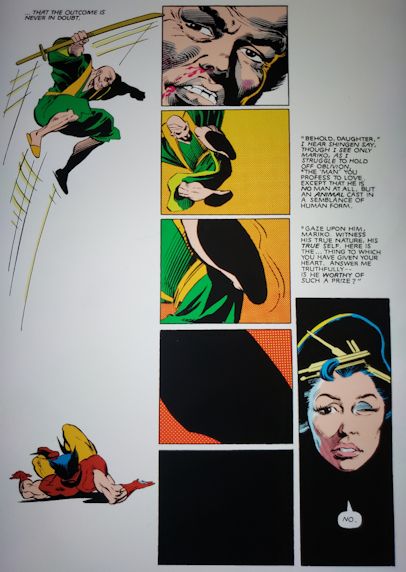
After the hunter is dealt with, Logan travels to Japan to see Mariko. Three weeks previously, Mariko had been recalled to Japan without a word to Logan. His letters to her have been returned to him with no word of explanation, and he’s unable to contact her at all. Some of this becomes clear when Logan arrives in Japan, when he meets with Asano Kimura, a Japanese spy and an old friend from Logan’s time with Canadian intelligence. Kimura explains some of the details—Mariko’s father, Lord Shingen, turned up alive after years of being presumed dead, and he reclaimed his place as lord of the Yashida Clan. In repayment for an old debt, Shingen promised Mariko’s hand in marriage, and she was forced to accept as a matter of honor. However, this is not enough for Logan, who decides that he must get answers from her directly. He decides to sneak into the ancestral Yashida home, where he eventually finds Mariko.
Her answers are not to Logan’s satisfaction. Mariko is bound by ancient tradition and rules of honor, and she cannot refuse if Shingen’s agreement was an honorable debt. However, the situation is worse than Logan imagined—Mariko’s face is bruised, presumably after being beaten by her new husband, and she is shamed by Logan seeing her in this state. Logan’s instinct is to kill Mariko’s husband, Noburo Hideki, but out of love for her, he decides to walk away instead. This appears to be the end of things at first, until Logan is knocked unconscious by poisoned shuriken.
When Logan awakens, he realizes he’s been brought before Lord Shingen, who seeks to shame him. Shingen presents Logan with what is ostensibly meant to be a friendly duel, fought with bokken—wooden swords that are used for solo practice in kata. This already is an insult to Logan on two levels. Shingen reveals the first, that he doesn’t consider Logan worthy of a true katana sword. The second is revealed during the fight, which is that bokken can inflict severe blunt force and cause injury even in practice training. As someone who owns such a sword, I can attest that bokken swords are thick and hard weapons, and though blunted and wielded like swords, they can do harm like wooden clubs. An actual friendly bout would likely have involved bamboo weapons, but Shingen’s aim is to dishonor and shame Logan, to bring him low.
Shingen succeeds in this goal, and it results in one of my favorite Wolverine fights of all time. The entire fight was a ruse, to manipulate Mariko into believing that Logan is unworthy of him. He does this by using his superior sword skill to strike Logan in his nerve clusters and other pressure points. Logan has already been slowed down significantly by the poisoned shuriken, and he doesn’t realize how skilled Shingen is as a swordsman. Shingen gets in several dishonorable hits, but they are designed to look clean to an untrained observer like Mariko. Logan, however, is aware of this, and he is goaded into dropping the sword and popping his claws. However, because Logan is still weak from the poison, Shingen is still able to batter Logan back into unconsciousness with the bokken. Logan becomes the bear from the beginning of the issue—wild, uncontrolled, driven by fury. By the end, when Shingen asks whether Logan is still worthy of her, she responds with a simple, reluctant “no”. However, it is possible that Mariko doesn’t truly believe this, and that she only says this so in the hopes that Shingen will spare his life. Still, the emotional impact stings, and Logan is left broken physically and emotionally, lost in the streets of Tokyo.
Shingen proves to be one of the more effective villains in Wolverine’s rogues gallery, exceeded only by Sabretooth and possibly Lady Deathstrike, although he only appears in this story. Shingen is in many ways the perfect opposite of Logan. Where Logan is an animalistic mutant with the heart of a samurai, Shingen is a born samurai with the heart of a monster. He is born to rank and privilege, but he only pretends to honor and does not truly possess it in his character. In this way, he is not unlike Stryker, another villain who feigns to character that he does not in fact possess. He cares only for his personal ambitions, and he is willing to use any dishonorable methods to achieve them. Claremont and Miller masterfully show this with the fight scene, which is as much a display of Shingen as a villain as it is of Logan’s inner conflict. The purpose of a good villain is to test the character of the hero in opposition. Through the first battle with Shingen, Logan is tested, and he fails the test, left with the choice to either rebuild or walk away.
The first issue ends with Logan finding an unexpected savior, a woman named Yukio, before he passes out once again. Yukio is a fascinating character, and one that often is involved in Logan’s various adventures in Japan, starting with this one. She is also a character that plays to Frank Miller’s sensibilities—he leans towards noirish anti-heroines quite often, whether it’s Elektra, Catwoman, or the women of Sin City. Yukio begins as Lord Shingen’s personal assassin, and she is sent initially to lure Logan away from Mariko. As a character, Yukio plays the “femme fatale” role that is often present in Miller stories, and for Wolverine, she is an effective one. As with Elektra before her, Yukio is designed to represent temptation, and thus she embodies everything that Wolverine wants but denies himself. She is dangerous, uninhibited and sexualized, representing the call of Wolverine’s animal self. At the same time, Yukio is not an evil character despite being a professional killer, and she genuinely cares for Logan in her own way.
The second issue opens with Yukio and Logan under attack by members of the Hand ninja clan. The Hand were created by Frank Miller as enemies of Daredevil, but Claremont and Miller brought them into this story. This story in many ways established the Hand as Wolverine villains, and to this day, they are shared by Wolverine and Daredevil as major adversaries. In this story, they are mainly soldier villains working for Shingen as hired assassins. However, they are no match for Logan, who dispatches them all despite their superior numbers. Still, they have served their purpose—to deny Logan time to think about the situation as Yukio draws him into her web.
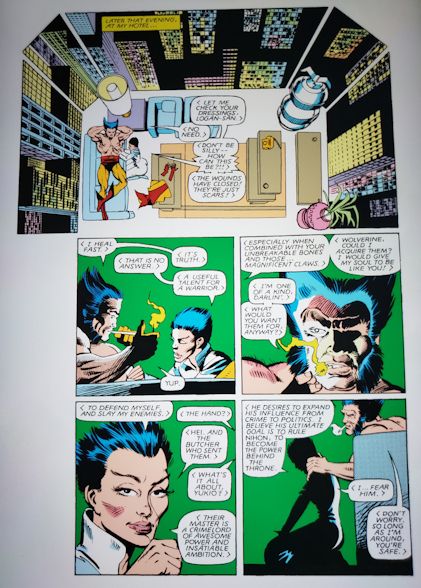
The following scene is designed for exposition, while also being the next phase of Yukio’s seduction of Logan. Yukio does not openly lie to Logan—most of the deception is based on omissions or half-truths. Certain elements are true, such as the fact that she’s afraid of a powerful crimelord who is trying to gain power in the political world. What she fails to tell him is that the crimelord she fears is, in fact, Lord Shingen himself. (That relationship is confirmed in the subsequent scene, where Yukio goes to Shingen to demand that he explain himself.) Yukio then attempts to seduce Logan, but he refuses—he is still in love with Mariko and will not betray her. This reflects Logan’s samurai side as he resists the temptation of his animal desires as represented by Yukio. Still, Logan agrees to help Yukio, not realizing her true loyalties or situation.
The final sequence of the story revolves around Yukio leading Logan to a meeting between Mariko’s husband Noburo and a rival crimelord named Katsuyori. The meeting takes place during a kabuki theater play, which is itself a perfect echo of the entire meeting. Neither side trusts the other, and the kabuki theater is a distraction from the real event. Noburo has brought Mariko along as part of Shingen’s plan—Shingen believes that Katsuyori will lower his guard if Mariko is at risk. In the end, it is an attempted assassination plot on both sides—the kabuki actors are Katsuyori’s assassins, while Logan and Yukio are sent as part of Shingen’s plan to kill Katsuyori. Seeing Mariko in danger, Wolverine slaughters the assassins, but only after they trigger his berserker rage. In an animal frenzy, Logan kills everyone except Katsuyori (Yukio kills him outside), all in front of Mariko. The issue ends with a shocked Mariko walking away while Logan looks on in shame, with Yukio having gotten what she wanted all along—Logan all to herself.
The following issue starts with a drunken Logan and Yukio having a good time, starting with a bar fight between Logan and a former sumo wrestler. However, Logan has a visitor—his friend Asano, who begs Logan for his help in stopping a powerful crimelord. Logan, in a drunken stupor and emotionally wounded, refuses him and goes off with Yukio. After an exchange between them and nearly getting run over by a bullet train, Logan passes out. However, they have been followed by the Hand, who demands that Yukio fulfill her obligation to Shingen and kill Wolverine. After a ruse, Yukio ultimately refuses; she loves Logan too much to agree to such a thing. However, she’s equally angry, as Logan mentions Mariko’s name in a barely conscious state, causing her to kick him back unconscious.
This issue is largely devoted to Yukio’s character development as well as Logan’s realization and epiphany about who he is and what he should be. Yukio stands at a crossroads, having burned her bridges with Shingen, but not having fully committed to helping Logan against him. This leads to a scene where Yukio returns to Logan’s home. An intruder arrives, and a paranoid Yukio, fearful of Shingen and the Hand, believes that the intruder is a ninja. Unfortunately, it turns out to be Asano, and Yukio unwittingly kills him, believing him to be a member of the Hand. This killing confirms to Logan the truth, that she’s been working for Shingen the entire time, which leads to a fight in a private rock garden. The Hand arrives, attempting to kill them both, but Logan prevails while Yukio manages to escape.
The final scene leads to Logan’s epiphany, as he looks down at the chaos that the battle has made of the rock garden. Chaos is his nature, but he aspires to be something more. He struggles within himself, feeling as though he destroys what he touches no matter what he does. He realizes that he failed the women who matter to him because he failed himself—he allowed himself to give in to the primal animal urges in his nature. Towards the end, Claremont has Logan realize what becomes the central point of Wolverine as a character—what makes him a man isn’t that he always succeeds, but that he makes the attempt to be a better man each day. Being a man, in the Claremont view, is to accept that humanity is flawed, but to strive towards something better and accept change. Trying to be perfect failed, and giving into his nature failed, but Logan can choose to be something else. He can accept who and what he is, but he can strive to be a man, make better choices for himself and those he loves. With that, Logan swears to bring down Shingen, which is the focus of the final issue.
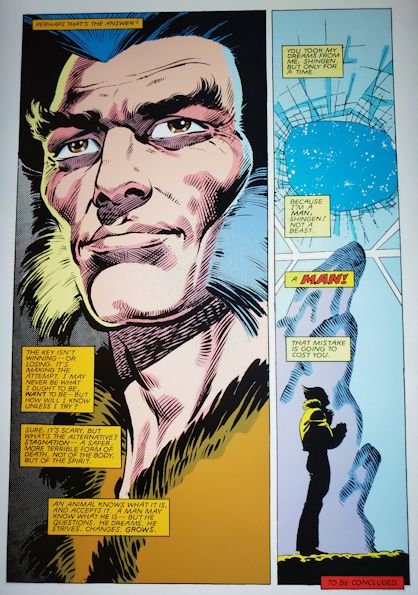
Most of the final issue consists of Logan gradually destroying Shingen’s criminal organization in Japan bit by bit. However, it’s clear that Logan has moved past animal instinct as his guiding force, as he has done for much of his life. Instead, he is using rational thought and planning, using weapons left by his enemies and tactics he learned as a Canadian secret agent. He is fighting Shingen on human terms, as a man would, and Claremont and Miller show the change in subtle ways. These tactics prove to be effective, as he damages Shingen’s operation so effectively that the underworld stops fearing Shingen.
We also finally get to see Mariko’s perspective on the events of this story. She is emotionally torn as she is bound by honor and duty as her father’s daughter. Mariko has come to realize that her father is evil and that he has dishonored the house of Yashida. Mariko had remembered him as a different man, but she abhors the man he has become and the stain he has caused on the family name. We eventually learn that Mariko is tempted to kill her father by her own hand, but she cannot put an end to her father without dishonoring herself. This becomes an ongoing thread with Mariko—she is an honorable woman, driven to duty at any cost, no matter what the cost to herself. This is the path of the samurai woman, and in this, she represents what Logan now strives for.
As Logan prepares for his final assault on the Yashida home, Yukio decides to make her own attempt on Shingen’s life. The ploy fails, as she is captured by the Hand and brought before Shingen. Yukio explains that she did this to atone for her killing of Asano, and Shingen is impressed enough by this to give her a fair chance to defend himself. Unfortunately for Yukio, she is outmatched, and Shingen beats her severely for her disloyalty. It is not until Mariko steps in and Logan arrives that Shingen stays his hand at all. In the end, rather than Yukio tempting Logan into the animal side of his nature, it is Logan who inspires Yukio towards the path of honor even at the cost of herself.
This decision ends up saving her life, as Logan has a chance to kill her for the killing of Asano and does nothing. Noburo attempts to flee, proving himself a coward, threatening Mariko in the hopes of Logan sparing his life. Taking advantage of Logan’s distraction, Yukio kills Noburo, saving both Logan and Mariko in the process. Honor having been satisfied, Logan decides to let Yukio go, unable to forgive Yukio for Asano’s death or repay her for Mariko’s life. However, at least for now, any hope of a love between them has been broken.
The final battle between Logan and Shingen is quite possibly the least Claremont-like scene that I can recall in the entire Claremont run. Chris Claremont has a reputation for wordiness that usually precedes him, and his name is synonymous with verbose writing today. The final battle with Shingen is completely wordless, perhaps because Claremont felt there was nothing substantial that he could add that the art doesn’t already speak for itself. Frank Miller’s visual storytelling in this issue is a masterclass on how art conveys the scene. Each move in the fight is clear and concise, the hatred between the two men shows in each frame, and the conclusion is stark and impactful. At the end, Shingen is dead, Logan is alive, and honor has been restored to the house of Yashida.
The ending proves ultimately to be a happy one, as Mariko explains herself to Logan and once more accepts his love. Logan was able to do what she was too afraid to, even though he feared that it would cost him everything. He decided as a man to reject his animal side, to fight Shingen as a man would, and he did so certain that he would pay a heavy price for his actions. Instead, by making the sacrifice play, Logan proves himself a man of honor by purging the Yashida clan of a great evil. This earns the love of Mariko, who presents Logan with the Yashida Clan’s Honor Sword, a weapon used only by the lord of the clan or its champion. With that, Logan becomes champion of Clan Yashida, and the final page ends with the announcement of Logan’s engagement to Mariko.
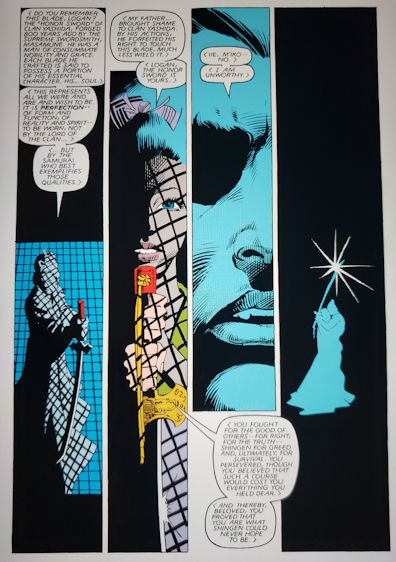
The Wolverine limited series is my favorite Logan story of all time, and it still holds up extremely well. Originally, my love for the series was rooted in Claremont’s mastery of characterization and how much this story defined Logan as a character. That much is still true, and to this day it is still Logan’s finest story as a character. However, I’ve grown to appreciate Frank Miller’s contribution to this series as well, and it cannot possibly be understated. The visual storytelling is simple but elegant, and each frame perfectly captures the point of the characters and their respective conflicts. Miller’s Eastern influences are apparent in the storytelling, as it draws from artists like Goseki Kojima in the layouts. At the same time, the characters are fully realized in a way that the best Western comics can achieve. Miller’s own contributions to the story are evident as well, and this story is fully a combination of a great writer and a legendary writer/artist at the height of their skills. If anything, I have a greater appreciation for the symbolism and subtext in this story; each of the important pieces connect to each other and the larger themes of the book. This is the book that made me a Wolverine fan when I first began reading comics, and I am still fond of this miniseries even now.
This story was also referenced on film during the Fox era in The Wolverine. Indeed, certain scenes and characters are lifted from the Wolverine limited series, including Logan’s encounter with the bear hunter. However, The Wolverine also makes some significant changes from the source material, enough that the film cannot truly be considered the same story. Still, it was a solid movie that pays respect to a great Wolverine story, even if it is fundamentally something else.
After this, we return to the pages of Uncanny X-Men, where Storm battles the Morlocks, Rogue joins the team, the X-Men go to Japan for Logan’s wedding, and an old enemy returns to haunt them. We’ll also discuss the introduction of Madelyne Pryor to the pages of the X-Men, before the character went horribly wrong. First though, we’ll look at Paul Smith’s involvement with the X-Men, and why Kitty Pryde thinks “Professor Xavier Is a Jerk!”
